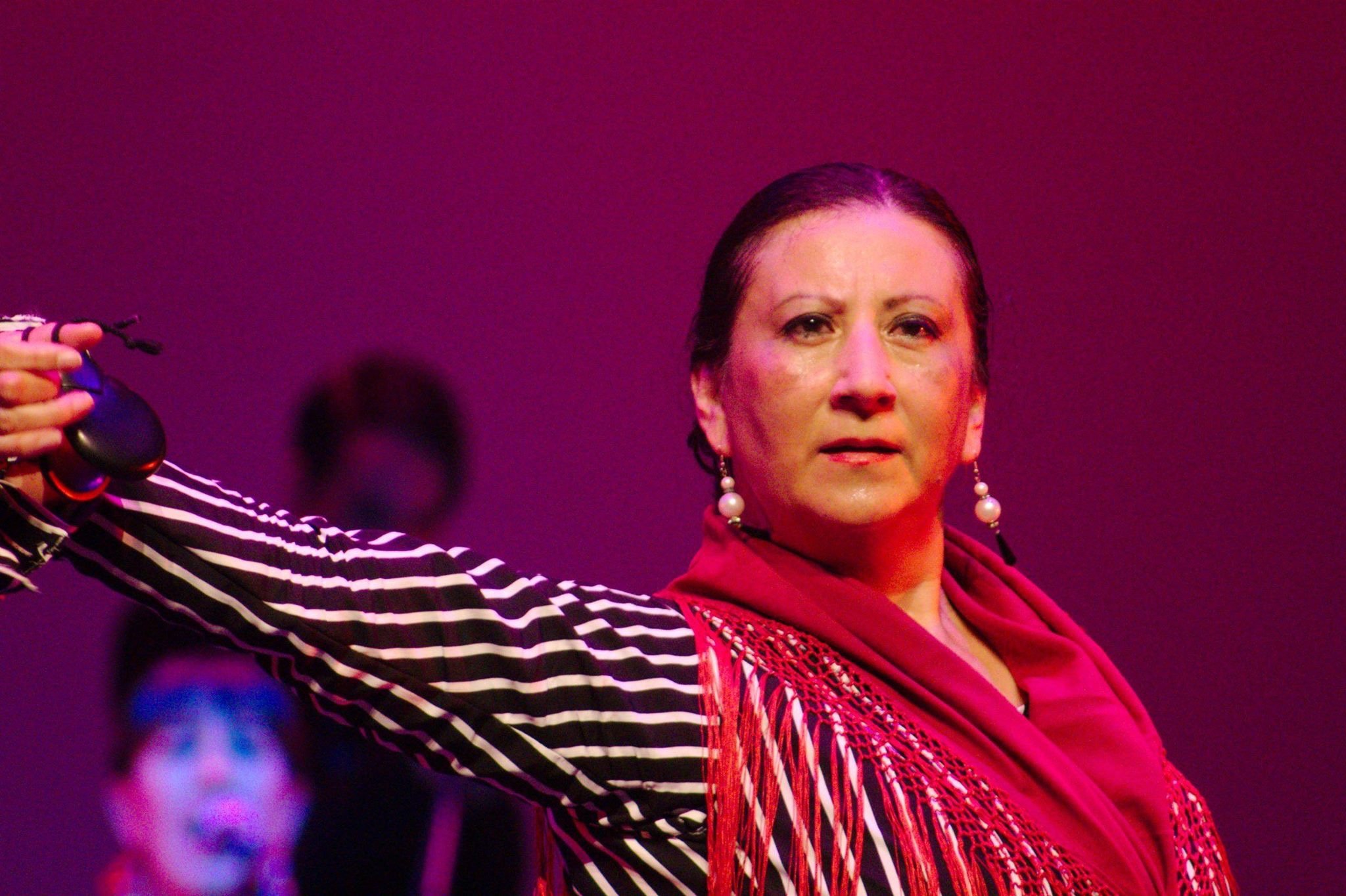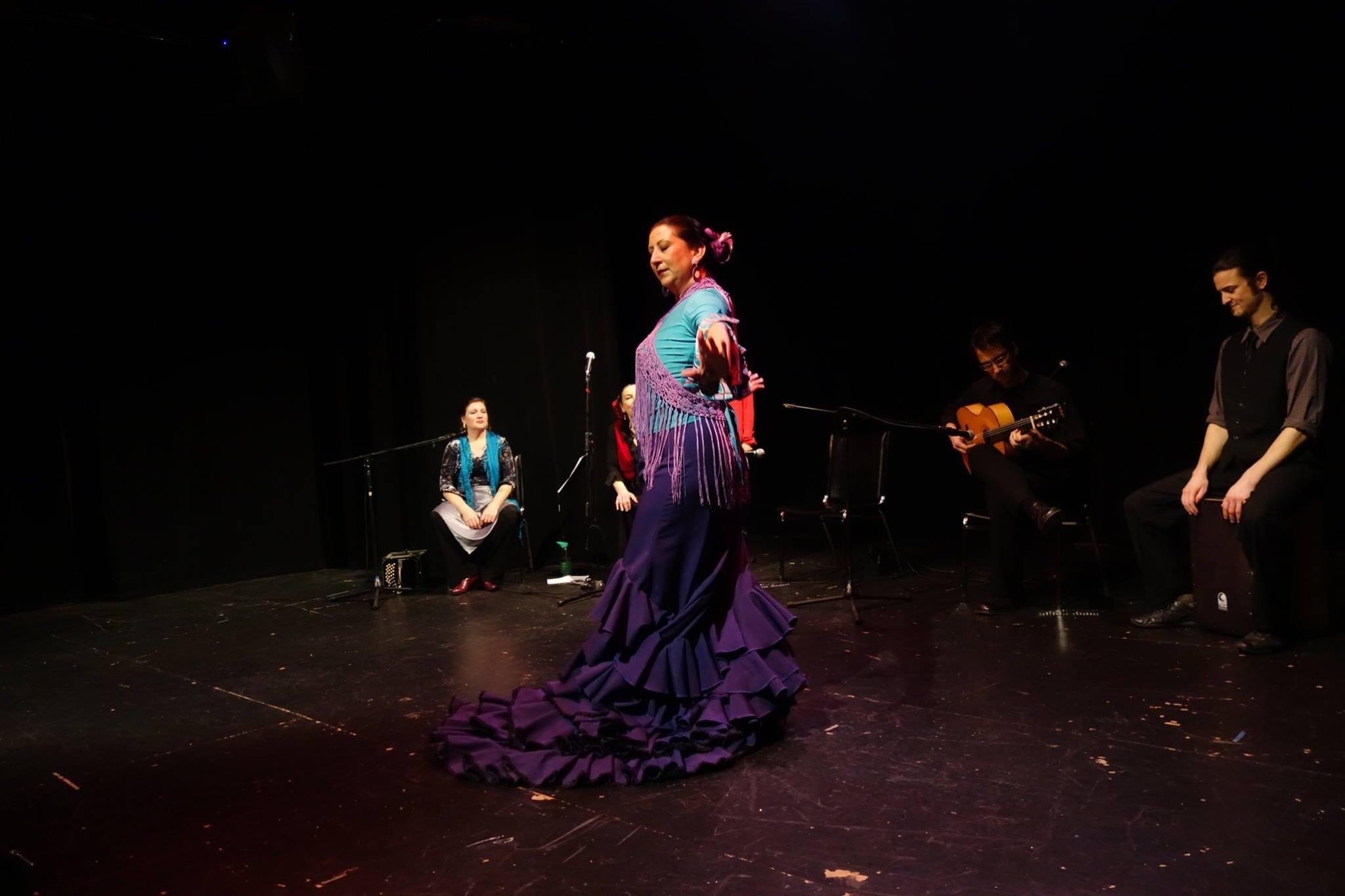Dances of Spain’s Jackie MacLin on Exploring the Rich Cultures of Flamenco
By Nicole Barrett, DWC Blog Editor
Photo by Janette MacKay
Flamenco is a vigorous rhythmic style of dance that comes from the southern tip of Spain. This highly-expressive art form is not only beautiful to watch but leaves the mover feeling powerful. Local flamenco instructor Jackie MacLin has been performing this invigorating dance style since she was young and knows the importance of passing on her knowledge to her dancers. Read on to learn more about Jackie’s dance journey and her mission in the world of flamenco!
Jackie started dancing when she was just 5 years old in her hometown of Santa Barbara, California. One of her family members was a former dancer and started a dance studio in her home. “She would move her dining room table out of the way and we would dance around,” she recalls. Jackie remembers her first performance where she wore sunglasses at nighttime and she shares that she couldn’t see well. She kept peering over the top of her glasses to see the audience and their reaction was laughter and applause. At that moment, she remembers instantly being hooked on performing on stage. From then on, she knew she wanted to dance.
Her teacher taught Mexican folk dancing and traditional Spanish dancing, which Jackie primarily did. In her hometown, there is a yearly fiesta that occurs called Old Spanish Days which is a celebration of the culture of the area. Jackie has always been involved in the fiesta, but when she was 16, she auditioned to be fiesta spirit and got the part. In this role, she represented the city and got to lead the parade, which was a very big honor for her.
Later on, she started teaching within the studio and she shares that she discovered flamenco after seeing it performed in Los Angeles. “I immediately said, ‘What is that? I need to do that, whatever that is I need to do that because it just spoke to me,” Jackie recalls, laughing. She and her dance mates would drive to go and take flamenco lessons, and she has been doing it ever since. She shares that despite the big milestones in her life like marriage and children, she was still continuing to teach and dance. Once she moved to Washington with her family, Jackie looked around the area for flamenco studios so she could continue her craft. She later started her own company Dances of Spain and has been teaching there ever since.
Photo by Janette MacKay
When asked about what her favorite thing about dance is, Jackie shares that she wouldn’t know what to do without it. In her experience, dance requires lots of physical and mental strength and she relates this to the connection between the upper body and lower body in flamenco dancing. She also shares that one of the things that she loves about flamenco specifically is its longevity. “As long as you can stand and move, you can still dance flamenco,” Jackie says. The small movements in flamenco allow the mover to completely take control of their emotion and that is something that Jackie really loves about this style of dance.
Because Jackie owns her own dance studio, she has found that one of her biggest struggles as a teacher is being able to give her students what they need. She shares that she learned flamenco in an untraditional way, meaning in the U.S., as others travel to Spain to get fully immersed in the culture. When learning flamenco, she just learned choreography, not the connection and feeling of the music. Because of this, Jackie didn’t understand what that all meant when she was teaching. In the end, she just wants to be able to explain flamenco clearly to her students and let them know the reasoning behind the movements they’re doing.
One of the biggest things that allowed Jackie to learn more about flamenco was asking questions when she was unsure. Because of this, she emphasizes the matter of being able to ask questions if dancers or teachers don’t understand something. She shares that in our time today, the internet has loads of information that dancers can turn to if they need help. She even says that she directs her own students to certain flamenco videos for reference as well. “Do your homework and really study your craft so that you really understand what it is that you’re doing,” she stresses.
While dance is slowly becoming more equal, Jackie would still love to see more men involved in dance, especially in flamenco. She shares that men play a big role in flamenco dance, as their movements are representatives of matadors and bullfights. Flamenco is a mixture of many different rich cultures coming from the southern tip of Spain, so men and women approach the movements in different ways which have been constantly evolving over the years.
Jackie believes that a way to tackle this issue is to get more men and boys involved in dance at younger ages. She has noticed that in some areas boys are discouraged to join dance because it can be “too feminine.” Jackie would love to see more schools and companies open up more dance classes for boys to allow them to experience dance. “Let them experience it and hope that they don’t see it as something boys can’t do, but something extremely exciting and really powerful,” Jackie shares.
Photo by Janette MacKay
Earlier this summer, Jackie just got done with her sixth annual flamenco showcase with Dances of Spain at Meydenbauer Theater on July 30th. Now in the fall, Jackie is hoping to focus more on the technical side of flamenco with her dancers in class. While running her studio, she also is a member of a non-profit, Espacio de Arte, where she is hoping to do some collaborations with other flamenco instructors in the area, so stay tuned for those announcements!
Be sure to check out the Dances of Spain website here for classes in flamenco dance!
About the Author
Disclaimer
All content found on the Dancewear Center Website, Instagram, Facebook, Pinterest, and all other relevant social media platforms including: text, images, audio, or other formats were created for informational purposes only. Offerings for continuing education credits are clearly identified and the appropriate target audience is identified. The Content is not intended to be a substitute for professional medical advice, diagnosis, or treatment. Always seek the advice of your physician or other qualified health provider with any questions you may have regarding a medical condition. Never disregard professional medical advice or delay in seeking it because of something you have read on this Website.
If you think you may have a medical emergency, call your doctor, go to the emergency department, or call 911 immediately. Dancewear Center does not recommend or endorse any specific tests, physicians, products, procedures, opinions, or other information that may be mentioned on dancewearcenter.net. Reliance on any information provided by dancewearcenter.net, Dancewear Center employees, contracted writers, or medical professionals presenting content for publication to Dancewear Center is solely at your own risk.
Links to educational content not created by Dancewear Center are taken at your own risk. Dancewear Center is not responsible for the claims of external websites and education companies.



